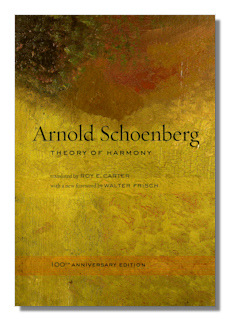
The Internet's Premier Classical Music Source
Related Links
-
Introduction
Acoustics
Ballet
Biographies
Chamber Music
Composers & Composition
Conducting
Criticism & Commentary
Discographies & CD Guides
Fiction
History
Humor
Illustrations & Photos
Instrumental
Lieder
Music Appreciation
Music Education
Music Industry
Music and the Mind
Opera
Orchestration
Reference Works
Scores
Thematic Indices
Theory & Analysis
Vocal Technique
Search Amazon
Recommended Links
Site News
 Book Review
Book Review
Theory of Harmony

Arnold Schoenberg, with a Foreword by Walter Frisch
University of California Press; 2nd edition (October 5, 2010) pp xxix + 440
ISBN-10: 0520266080
ISBN-13: 978-0520266087
It's not always fully appreciated just how prolific a writer on music the composer Arnold Schoenberg (1874-1951) was. And when you consider the ways in which he extended (and eventually subverted) the lush and harmonically rich music of Brahms and Wagner, it's hardly surprising that one of the composer's most successful and downright useful books should be the Harmonielehre or "Theory of Harmony", which was first published in 1911). Indeed, it was famously dedicated "the the hallowed memory of Gustav Mahler" (even though the latter equally famously claimed that the basis for all of his music was counterpoint! Harmonielehre remains one of the most influential books on the theory of music and valid as a source, reference and didactic text to this day.
Originally published by Universal Edition (which was founded in 1901 in Vienna), this latest edition by Roy Carter from Yale University Press commemorates the 100th anniversary of that first publication even though it's based on the third edition, of 1922. At over 400 pages of substantive text, composers, performers and listeners will still derive a great deal from the book today; it is a classic as worthy of that appellation as are Hindemith's "Craft of Musical Composition" and Piston's own book on Harmony.
There are good reasons for today's musicians and performers, composers and listeners to revisit Theory of Harmony aside from its value as an historical document: in addition to the insight it affords into the (musical) development of one of modern music's most important figures, it sets ground rules which have yet to be superseded for this area of the interface between theory and aesthetics. Its tone kept the informality of its roots… in the teaching (and the learning – as the book's celebrated first sentence attests) which Schoenberg undertook in Vienna in the early years of the last century.
Schoenberg's text is divided into 22 chapters of between just a couple and over 60 pages intelligently setting out the ways in which musical understanding in the first decade of the twentieth century worked with consonance and dissonance; chords; modes and scales; modulation; the relationship between rhythm and harmony; tonality; and the implicit move towards tone rows. If that's not quite what you would expect from Schoenberg the expressionist romantic who is also Schoenberg the pantonalist, that's because this book stands on the cusp of his move from the one world to the other. Indeed, his more "advanced" ideas on tonality come towards the later chapters. For all the fact that Schoenberg was revolutionizing music at the time this was being written, and might have been expected to want to promote a particular idea, the book is extremely comprehensive. It covers almost every conceivable area of harmonic theory, including fundamental bass and dualism.
Theory of Harmony is just as significant because it proposes a number of innovations – and supports them more than adequately: firstly, that there is nothing (other than degree) inherently different between consonance and dissonance ("two is not the opposite of ten", says Schoenberg [p. 21]). Non-harmonic tones, by extension, cannot exist. And the relationship between freedom, intuition, innovation and the harmonic rules and praxes that had governed music for centuries should be examined; and overthrown.
Perhaps most significant of all the ideas which Schoenberg proposes is that tone color has a status equal in importance to that of pitch and rhythm. These ideas are well developed and their coverage in Theory of Harmony make a good starting point for further exploration and understanding of how music in the century which has followed has developed. The connections which Schoenberg makes with the unconscious is an abstract, but very well-developed one; it parallels, of course, changes afoot at this time in the works of Freud, and indeed Einstein and Kandinsky.
It could never be claimed that the text is anything but dense, needs very close and careful following, and only really yields its import if followed logically, and from beginning to end in sequence. The layout, font, design and manner in which this edition has been produced facilitate this significantly. The size of the score extracts, for example, is large and clear enough to make following them easy. The footnoting and indexing likewise. It's also clear that the editorial oversight, proofing and general consistency of English orthography (the book was written in German, of course) are exemplary.
Composers, those who wish to understand more deeply and indeed listeners to classical music in the 21st century could do far worse than read through Schoenberg's Theory of Harmony for a thorough explanation and beautifully-constructed text exploring (and offering unambiguous guidance – from one who knew – on) all aspects of how musical harmony works. Additional interest is to be derived from the way that the book is both rooted firmly in German, Austro-Hungarian (academic) traditions and yet opens multiple doors on the new and revolutionary currents about to change music for good. Yet handles both registers with equal refinement and persuasiveness. Definitely one for the shelves.
Copyright © 2010 by Mark Sealey.



















